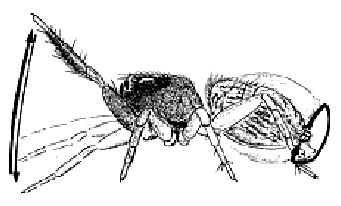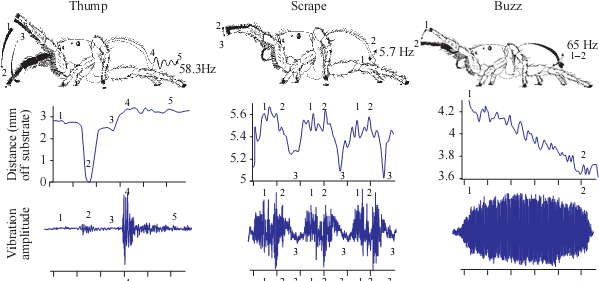To continue in the unintentional theme of bug mating rituals and to see if I can work out how to embed a video here is a cool video of a male jumping spider courting a female:
The sound is half the fun so don’t forget to turn up your speakers. It seems like it must be a part of some research project with the fancy recording set up but I’m not sure who made it. Anyway it seemed pretty cool, so I took a quick look at the literature to see what was going on.
At first glance, it looks like the spider is making the noise with his front legs but it turns out that, according to research by Noordam, he is actually using a specialized hardened region on the bottom of his abdomen to bang on the ground at the same time he moves his arms (At third glance, it looks like he’s not really hitting the ground with his abdomen. See the update below.). If you look closely on the video you can see his tail end moving up and down in time with the sounds.

Rypstra, Wieg, Walker, Persons found female spiders are more likely to copulate if the male does more arm and body shakes. On the other hand, the male is more likely to work harder at his jitterbug if he can detect pheromones indicating the female has not yet mated. Next time I see a couple spiders together, I’m going to be looking for dancing.
Update
Dale Hoyt left a helpful comment that points out that the abdomen isn’t actually touching the ground when when the sounds are being made. I had assumed it was a trick of the lighting but looking closer now, there really doesn’t appear to be any contact. Luckily he suggested the search term “stridulation” (a shrill grating, chirping, or hissing sound made by rubbing body parts together) that produced much better results from the literature. The video may have been from (or based on a) study by Elias, Mason, Maddison and Hoy where they studied the vibrational aspects of spider dancing. Their experimental setup sounds a lot like what’s in the video:
The arena substrate floor for courtship was a sheet of graph paper attached to a square cardboard frame (60 cm×45 cm). Females were tethered as above [anesthetized with CO2 and attached to a wire with low melting point wax], and the male’s seismic signals recorded using a piezo-electric sensor placed directly underneath the tethered female.
Didn’t seem to bother the male much that she was unconscious and restrained. Anyway, the researchers found three different types of seismic signaling and labeled them (using highly technical terminology): thumps, buzzes and scrapes. They made a really cool figure that demonstrates each of the types:

Top panels show body positions, with numbers (1–5) illustrating movements of the forelegs and abdomen. Middle panels show the position of one of the forelegs (mm above the substrate). Bottom panels show the oscillograms of the seismic signals.
Thump signal: Front legs come down (1–2), contact the substrate and quickly move back up (2–3). Shortly afterwards the abdomen is pulled back and released, and the abdomen ‘rings’ at 58.3 Hz (4–5). Thumps are broadband signals with peak frequencies at 203 Hz and 1203 Hz. Production of signal corresponds with the percussive contact of the front legs against the substrate (1–2) and movements of the abdomen (4–5).
Scrape signal: Abdomen moves up (1–2) and shortly afterwards the front legs come down (2–3). Scrapes occur in groups with a frequency of 5.7 Hz. Scrapes are broadband signals with peak frequencies at 230 Hz and 550 Hz. Production of seismic signal corresponds to movements of the abdomen.
Buzz signal: Front legs come down (1–2) as the abdomen oscillates at 65 Hz (1–2). This signal has a fundamental frequency at 65 Hz with several harmonic frequencies (130 Hz, 195 Hz and 260 Hz). Production of seismic signal corresponds with movements of the front legs and abdomen.
[Edited slightly]
Elias et al. found that thumps came from the front legs impacting the ground, scrapes were produced by rubbing together a set of bristles between the head and body, and buzzes were made by the spider vibrating its body. They note that their research species (Habronattus dossenus) is the only species known to produce all three of these signals. It sounds like the spider in the video does all three of these so I guess that means it’s a H. dossenus.
In a follow up study, Elias, Hebets, Hoy and Mason investigated the results of muting the males by using wax to connect the spider’s head and body. They found females were more likely to mate and waited less time before mating with vibrating males. In addition, many of the muted males were eaten before getting a chance to mate.
I’m glad I finally tracked down the rest of the story (I hope). It turns out that some spiders bang their abdomens against the ground but the spider in the video is actually do a much more complex dance. Spider sure have some interesting mating patterns.
References
A. P. Noordam. 2002. Abdominal percussion and ventral scutum in male Euophrys frontalis (Araneae: Salticidae). Entomologische Berichten, Amsterdam. 62:17-19
A. L. Rypstra, C. Wieg, S. E. Walker & M. H. Persons. 2003. Mutual mate assessment in wolf spiders: differences in the cues used by males and females. Ethology. 109:315-325
D. O. Elias, A. C. Mason, W. P. Maddison & R. R. Hoy. 2005. Seismic signals in a courting male jumping spider (Araneae: Salticidae). Journal of Experimental Biology, 206:4029-4039
D. O. Elias, E. A. Hebets, R. R. Hoy & A. C. Mason. 2005. Seismic signals are crucial for male mating success in a visual specialist jumping spider (Araneae: Salticidae). Animal Behaviour. 69:931–938
Thanks to Harley for showing me the video
(Another) Update: TheBrummel confirms that the video came from Dr. Madisson or his group and points to a bunch of additional courtship videos of jumping spiders.
Dale Hoyt | 14-Aug-07 at 12:31 pm | Permalink
I don’t have access to the papers, but it looks to me like the spider is stridulating — making the sound by moving its hind legs against the abdomen, or vice versa. Note that the abdomen doesn’t contact the substrate during sound production. The abdomenal vibrations are accompanied by movement of the hind legs, which are readjusted after a burst of sound is produced.
Is this possible?
ScottS-M | 14-Aug-07 at 1:41 pm | Permalink
@Dale Hoyt
I think you’re right. The Noordam paper seemed a bit brief so I probably shouldn’t have put a whole lot of stock in it but here is the relevant passage:
Now that I read it closer 0.15 seconds seem much slower than the vibrations in the video. And the tip of the abdomen doesn’t seem to be meeting its shadow. Must be a different species of jumping spider. I’ll add an update to the main entry. Thanks for pointing that out.
dan | 16-Aug-07 at 4:46 pm | Permalink
She doesn’t seem too impressed with him. Poor guy.
CM | 16-Aug-07 at 11:55 pm | Permalink
“Didn’t seem to bother the male much that she was unconscious and restrained.”
Typical…
Mark Lawton | 06-Sep-07 at 9:09 am | Permalink
I tried tracking down vibrating sounds, it was more like rubbing a wet finger across a rubber balloon, in the woods behind my house. All I could see in the 3 locations of the sounds were large webs among some logs and brush that I had piled up. I assumed that it might be the spiders but I couldn’t see them as they were recessed in their dens. I’ll try to get pictures for identification.
ScottS-M | 06-Sep-07 at 11:09 am | Permalink
@Mark Lawton
That sounds pretty cool. I’m not sure how loud spider vibrating would be in the wild but it might be amplified if they were on a leaf or something. Let me know how the hunt goes.
Mark Lawton | 10-Sep-07 at 11:19 am | Permalink
False alarm. After waiting and watching with camera in hand I have now come to the conclusion that it’s not the spiders that are making the noise that I’m hearing. I watched a couple of them and they were doing nothing at the same time I could hear the noise. Closer scrutiny revealed that the sound was coming from inside the pine logs that the spiders were on. It appears to be the sound of the woodborers that are nicely turning the logs into piles of wood shavings. They are making tunnels about 3/16 of an inch in diameter and are pulling out slivers that are about 1/4 inch in length. The way they are biting the slivers free inside the log is resonating out of the dry pine. I’m not going to go thru the trouble of cutting the logs open to track down what type of borer it is at this time. I’ll just search to see if anyone else has checked out similar sounds.
TheBrummell | 17-Oct-07 at 8:18 pm | Permalink
This video was made either by Dr. Wayne Maddison, now of the University of British Columbia (UBC) or one of his associates. He presented it in a talk I attended several years ago.
It’s a fascinating video, and he’s got lots more – some are up on the Tree of Life website (track down through the tree until you get to the jumping spider family). The funniest part about it is the fact that this particular female is not “unconscious and restrained” – she’s dead and pinned! Also, she’s not his species. Insert witticism relating to male preferences here. A slightly longer version of the video shows him bashing his head against the insect pin that’s through her thorax.
ScottS-M | 18-Oct-07 at 11:47 pm | Permalink
@TheBrummell
Thanks for the information. I added a small update to the post.